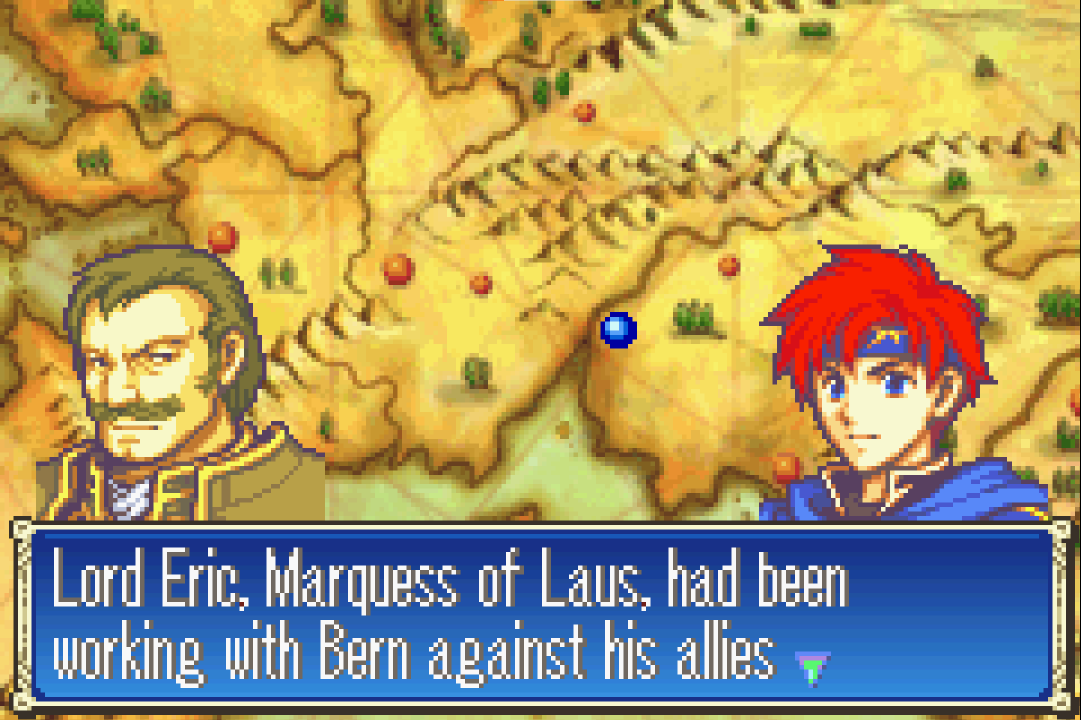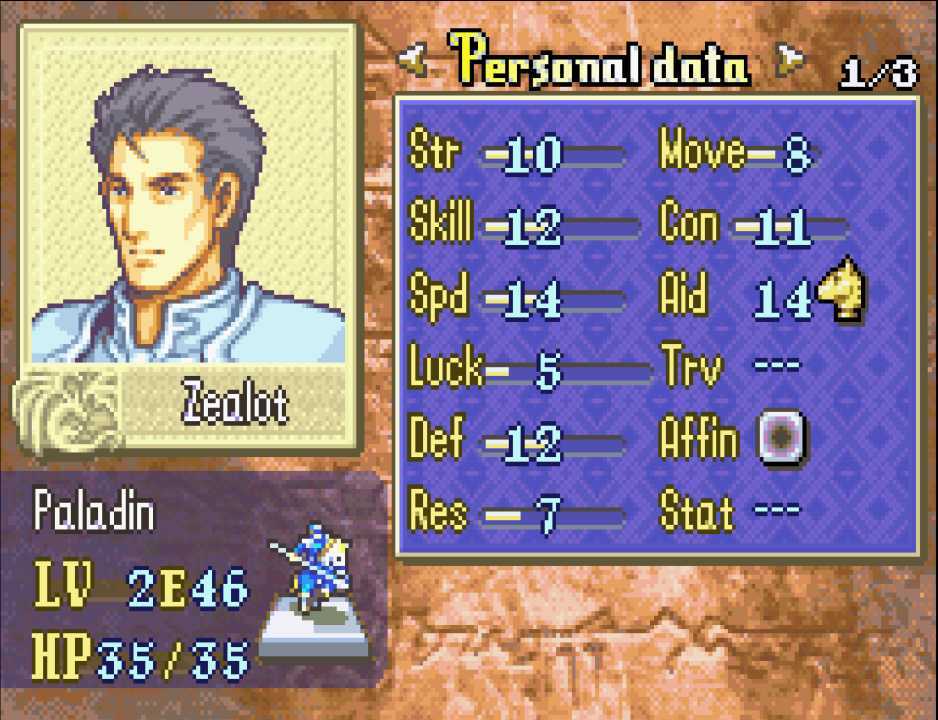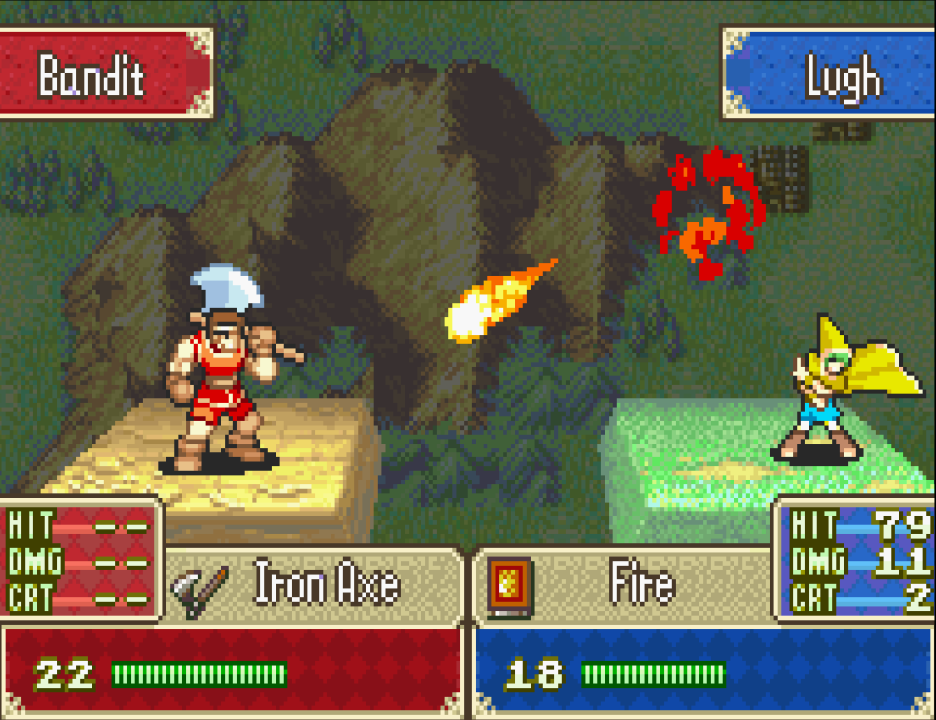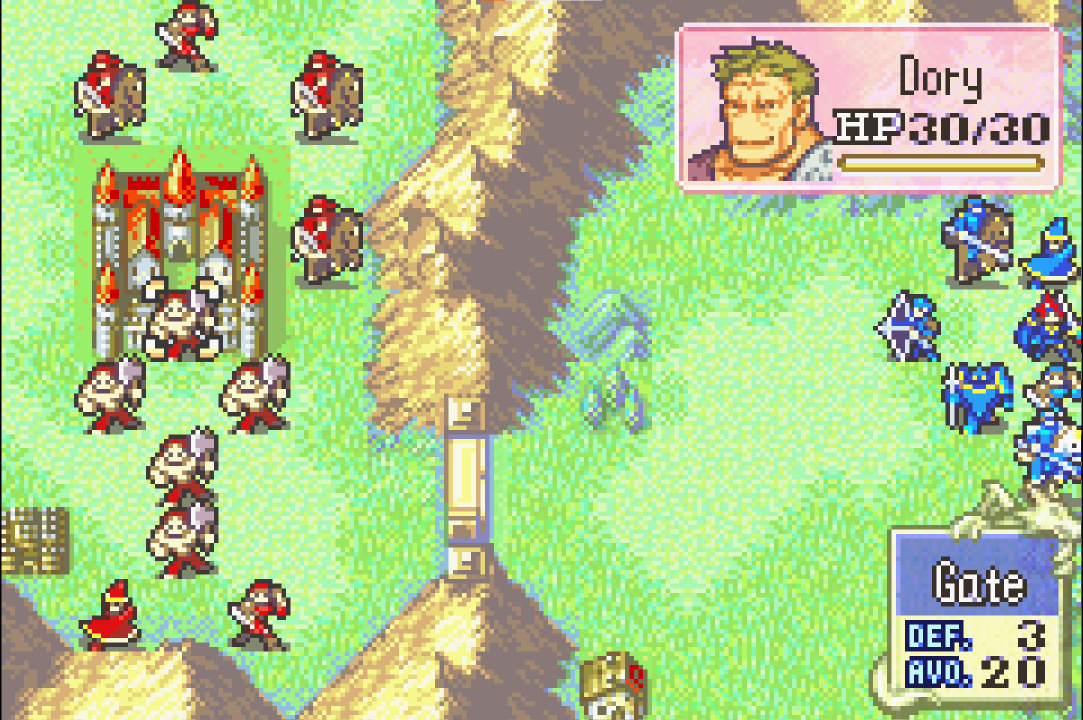Many people first encountered Fire Emblem in 2001 when Super Smash Bros. Melee came out on the Nintendo GameCube. No Fire Emblem game would release in the west for two more years, but one of the two Fire Emblem characters in Melee, Roy, was included in Smash to build hype for 2002’s Fire Emblem: The Binding Blade. While this game was never released in the West, fans can play Fire Emblem the Binding Blade today through fan translations.
GBA Fire Emblem games were my introduction to the series, so playing Fire Emblem: The Binding Blade for the first time, I felt right at home. The game adds a few new gameplay mechanics to the series and refines some of the best features from previous entries. The weapon triangle returns, while high variance or obscure mechanics like vigor and leadership stars from Fire Emblem: Thracia 776 have been phased out. The result is a more streamlined Fire Emblem game. Every mechanic in Fire Emblem: The Binding Blade is easy to grasp, unlike in previous games, where mechanics could be more esoteric.
The game follows Roy, heir to Pharae, a territory in a federation of countries and territories called the Lycian League. The Lycian League is just one powerful faction among many on the continent of Elibe and was founded by a group of legendary heroes who helped humanity win a war against dragons many years ago. In the present, the Lycian alliance is caught by surprise when a neighboring nation, Bern, begins taking military action around the border.
With his father ill, Roy must lead Pherae’s army to defend Lycia and uncover Bern’s motivation for attacking. The stakes quickly escalate to more than just a war for Lycia, as it becomes clear Bern has ambitions on a global scale that could spell disaster for all of Elibe. This story doesn’t hit the highs of the previous two Fire Emblem games, but it’s still an enjoyable fantasy romp.

As the stakes escalate, so does Roy’s army. While you begin the game with a weak Roy and a small band of soldiers, you have a grizzled, well-trained army by the end of the game with members ranging from elderly druids to reformed bandits and renowned military generals. The character variety is a strong point in Fire Emblem: The Binding Blade. There are 50+ characters available, all with unique designs and personalities. Those personalities all get a chance to shine via the support system. If characters spend enough time battling next to each other, they can unlock support conversations.
Support conversations are generally tangential or inconsequential to the plot, and they provide a great means of characterizing units that aren’t as relevant to the main story. Support conversations are this game’s biggest contribution to the Fire Emblem franchise and have become a mainstay feature of the series. Units that support each other are also stronger when they fight near each other, so there’s lots of incentive to ensure your units build up supports. The only issue with supports is that they can take a long time to unlock. A pair of units can take anywhere from 60 to 200 turns to unlock all of their support conversations.
My entire playthrough took a little over 400 turns. Considering some characters join towards the end of the game, I would not have had enough time to build their supports without spending extra turns doing nothing but waiting for supports to grow. This isn’t a game-breaking issue, but it would be nice if supports could be built less tediously. Despite these issues, the support system is a massive win for Fire Emblem: Binding Blade. Without supports, I wouldn’t have been able to enjoy characters like Noah and Zealot, who have minimal dialogue outside of their support conversations.

Beyond the story and characterization, Fire Emblem: The Binding Blade brings with it my favorite era of Fire Emblem visuals. Like previous entries, the visuals are all pixel art, but they pack a surprising amount of detail into each character portrait for a GBA game. The real showstopper, though, is the combat animations. Every class has a unique animation for attacks, dodges, and critical hits. These animations add a ton of character to each class, and some of the critical hit animations are so over the top that I considered using critical-hit-raising weapons more often just to see the animations more.
The fun story and great presentation of Fire Emblem: The Binding Blade are supported by mostly interesting maps and gameplay. The game does a good job of slowly building complexity, as early maps are usually small-scale skirmishes with only a handful of enemy troops. By the end of the game, maps are often larger or sport more complicated gimmicks.
While most of the maps in Fire Emblem: The Binding Blade are enjoyable, there are a few infamous maps in the game, such as one that combines desert terrain with fog of war, two of the series’ more frustrating features. Another frustrating mechanic often used in this game is enemy reinforcements that move as soon as they spawn. While these reinforcements can be managed with careful play or trial and error, it feels bad to have to replay a map because a unit died to an enemy that spawned right next to them.
Notably, customization features like children units in Fire Emblem: Genealogy of the Holy War or scrolls in Fire Emblem: Thracia 776 are absent in this game. Instead, long-term strategy comes from choosing which units to use and how to distribute your limited promotion and stat-boosting items.

Promotion items can be tricky to plan for because each promotion item only works for a few classes. For example, a Knight Crest can only be used to promote a cavalier or a knight. You get a limited amount of each promotion item, which can affect which units you choose to use. This limitation makes for some interesting challenges on second playthroughs, but it can be frustrating on first playthroughs since you won’t know how many of each item you get and when they appear.
A common strategy among experienced players is to only commit to one cavalier as a long-term unit early in the game due to a long gap between your first Knight Crest and the second one. A new player won’t know this and might end up with one or more cavaliers stuck in their base class for a long time.Replay value in Fire Emblem: The Binding Blade comes from choosing which units you want to use. You could do several playthroughs with entirely different armies, changing how you approach each map. Additionally, the game includes a pair of route splits, so you may want to replay the game several times to see all the content.
Confusingly, requirements for route splits are hidden. The more significant route split in the game is based on whether your pegasus knights or nomads have gained more experience. Players are unlikely to discover this requirement on their own and may not even realize there was a route split. Players that particularly like pegasus knights could replay the game multiple times and never see the other route. The route split isn’t the only esoteric element of Fire Emblem: The Binding Blade. The game also has seven unlockable chapters, each of which rewards you with a powerful legendary weapon. While these chapters are optional, you need to unlock and complete them to get the good ending and access the real final chapter.
You also need to make sure you don’t use up all the durability on any of the weapons you receive from these chapters. While the game makes it clear that the legendary weapons are important, it is easy to miss an optional chapter if you don’t know the requirements to unlock it and are playing at a slow pace. The bad ending isn’t that bad, but it’s still disappointing if you want to play every chapter the game has to offer.
Ultimately, these are minor frustrations and can be easily avoided with a spoiler-free guide. Although, unlike some previous Fire Emblem games, Fire Emblem: The Binding Blade is perfectly enjoyable without any guidance, as long as you don’t mind potentially getting a worse ending.

One other noteworthy change in Fire Emblem: The Binding Blade is the way random number generation occurs. In previous Fire Emblem games, one random number is generated every time a random event (such as an attack) occurs. In Fire Emblem: The Binding Blade, two random numbers are generated and averaged. The effect of this change is that displayed hit rates can be significantly different than actual hit rates. The difference between displayed and true hit rates is more extreme the further the displayed number is from 50%. For example, a 30% hit rate in Fire Emblem: The Binding Blade actually hits about 18% of the time.
This system generally favors player units since enemies tend to have lower hit rates than allies (barring some of the more difficult enemies on hard mode). Despite this, Fire Emblem: The Binding Blade is known for frequent missed attacks by allies and enemies alike because weapons have low accuracy in this game relative to other GBA Fire Emblem games. Hit rates in Fire Emblem: The Binding Blade are often very shaky. Planning around frequent missed attacks is essential for success.
A more obvious change in Fire Emblem: The Binding Blade is the upgrade to the battle preparations screen. As in previous games, before each battle, you have a chance to manage your unit’s inventories and select which units to deploy. New to this game is the ability to change the starting position of your units on the map. Finally, you can make sure your cavalry starts in front of your squishy magic users. While this may seem like a minor change, being able to adjust unit positioning before a battle makes many strategies possible that wouldn’t have been with the default unit positioning.
Despite only adding a few new features, Fire Emblem: The Binding Blade creates fun strategic gameplay by simplifying and refining some of the best features from early Fire Emblem games. The game also added the now-iconic support system alongside bombastic visuals that make every fight a joy to watch, building a strong foundation for Fire Emblem’s GBA era.


